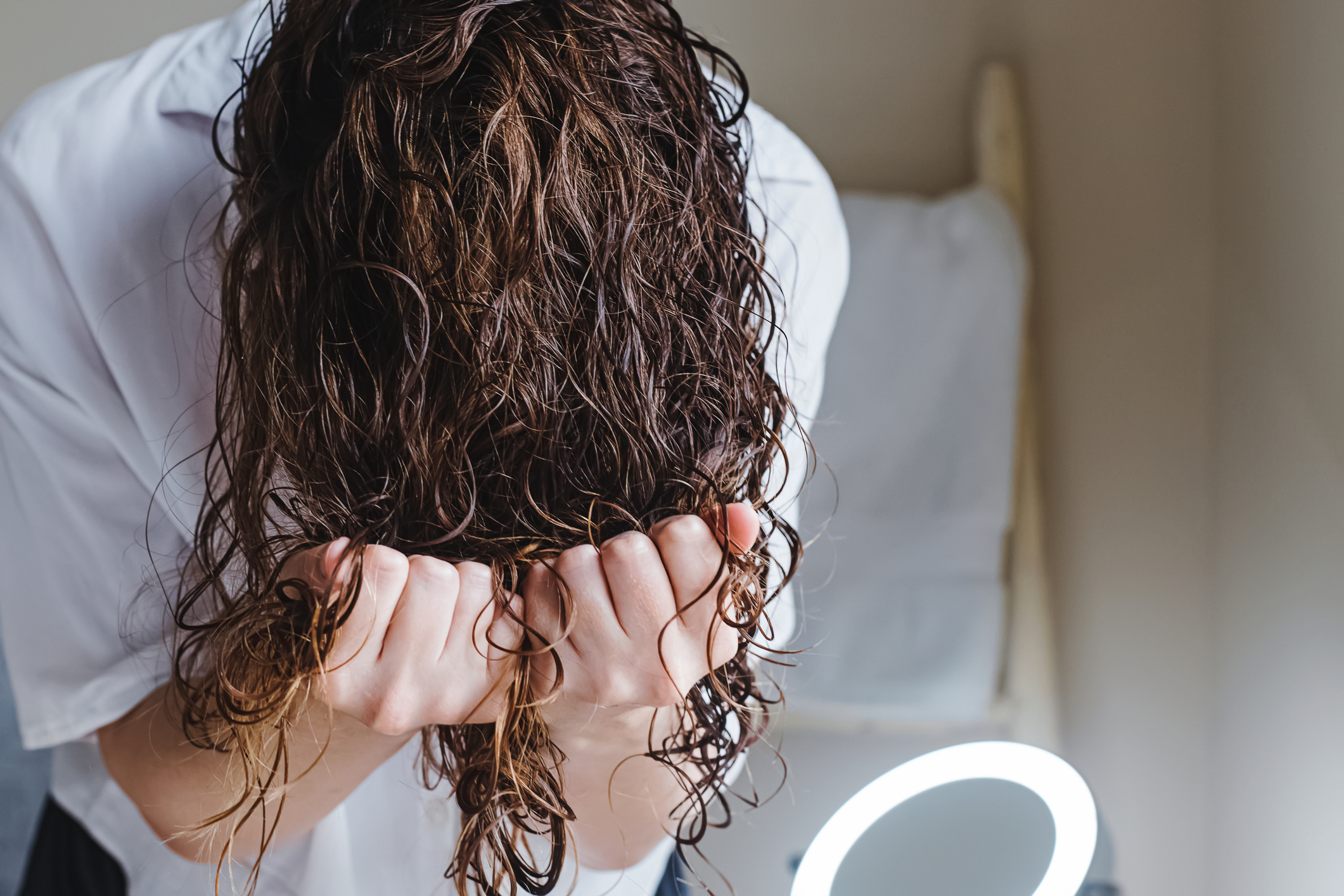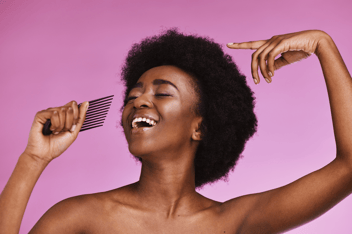 5min
5min
There are lots of answers to the question of how to dry curly hair, but only really one answer if you want to know which is the best approach to take. (Spoiler: it involves using a diffuser).
When you’re drying curly hair you ideally want three things – to maintain the health of your hair (curly hair is notoriously prone to breakage), to enhance your natural curl pattern and to minimise frizz. The only way you’re going to score a curly-haired hattrick of all three is by using a diffuser which has been specifically designed with your hair type in mind.
Here we look at the pros and cons of the different drying techniques for curly hair, from air drying and plopping to drying with a standard hairdryer. If you weren’t a diffuser convert already, you will be by the end…
How to dry curly hair without using styling tools
If you want to go at natural when learning how to dry curly hair, these are the heat and tool-free options to try…
Air dry
Air drying is the simplest and most self-explanatory way to dry curly hair. All you need to do is wash your hair, apply your styling products and leave it to its own devices.
The biggest pro of air drying is that you’re not using any heat on the hair, but what this does unfortunately mean is that your strands are left in their most fragile state (i.e. wet) for longer. This isn’t ideal, and especially not if you’re hopping into bed when your hair’s still sopping.
Old wives' tales about catching a cold aside, the friction between wet curly hair and your pillow can lead to frizz and snagging. Plus, very few of us stay completely still during the night, and tossing and turning, or sleeping on one side more than the other, can mean you wake up to uneven and potentially quite dishevelled curls rather than the beautiful, defined ones you spiralled and scrunched them into post-shampoo.
Also, this method is really time-consuming. If you have fine hair, it’ll probably air dry in a couple of hours, but that won’t be the case if you have a thick mane that holds tight to moisture. In this instance, it’s hard to find a convenient time to air dry when you’re not sleeping or out and about.
Plopping with microfibre towel
Plopping is a popular tool-less drying technique for curly hair.
It’s pretty much the same as air drying, except it involves piling wet hair on top of your head and wrapping it in a microfibre towel (they’re softer and more absorbent than cotton) to soak up moisture and speed up drying time.
Again, the key drawback is time – plopping isn’t a quick, pre-work fix, and turning up to the office with a towel on your head is probably even less practical and professional than arriving with sopping wet hair.
You also have very little control over your finished look, as you can’t tweak or see your curls as they’re drying – a bit like popping a cake in the oven and hoping for the best when the timer goes off.
Looking for a way to make your curls last longer between washes? Discover "The ultimate guide to keeping your curls looking great between washes".
Alternative methods for drying curly hair
Air drying and plopping not for you? These are your options for how to dry curly hair with the help of a heated tool…
Using a traditional hairdryer or multi-styler
If you want to dry your curls as quickly as possible, then a traditional hairdryer used either as it comes or with a precision, smoothing nozzle snapped onto the end is your best option.
But, this level of speed comes at a price, and what a hairdryer like this isn’t going to do is respect your hair health or preserve your curl pattern. Most standard hairdryers made for all hair types work at a very high wattage of over 2000, whereas curly hair only needs around 700W.
They also function at high-temperature settings which can dry out your strands, and gale-worthy speed settings, which, combined with a smaller nozzle that concentrates the airflow into one powerful jet, mean that the hair is hit with a gust of hot air that knocks all of the bounce and spring out of your spirals. Speedy? Absolutely. Kind to your curls? Not so much.
Using a diffuser
If you don’t want to have to choose between time-efficient drying and defined, frizz-free curls, then a diffuser is your best bet. The low voltage plus gentle heat and speed settings mean it’s much faster than air drying or plopping, but more respectful than blasting your curls with a traditional hair dryer.
These features will help to eliminate frizz, as you’re not causing any structural damage to the hair that could allow moisture to sneak in and fluff up your strands. Even better, a diffuser will preserve both your natural curl pattern and any shapes that you created by scrunching or finger-spiralling post-shower, as it’s not whipping your hair around at high speeds.
The wide surface area of a diffuser head combined with a perforated grid system that distributes airflow through a series of perfectly spaced holes means even drying across your entire head.
And, that no section of the hair is more exposed to heat than another. The finger-like nodules also give you more control over your finished look, without the need to use your actual fingers, which can create frizz and cause snapping.
They can be used to stretch out tight coils and curls, to separate spirals for maximum definition, and to encourage bounce in wavy strands. Ultimately, diffusing is the only method that’s been specifically designed to answer the question of how to blow-dry curly hair, making it our top pick for all types of curls.
How to dry curly hair with the Bellissima Diffon Supreme for perfect curls and waves
Not all diffusers for curly hair boast the same features, and the Bellissima Diffon Supreme is the crème de la crème. If you’ve previously avoided using a diffuser because you thought it might be complicated or fiddly, you’ll be pleased to know that this is intuitive to use in a multitude of different ways, making it easy to master the right techniques for your curl type.
The ergonomic, hand-held design can be used at any angle (including upside down) and the built-in head means it won’t fall off during styling.
You could pixie diffuse where you flip your head upside down and gather sections of curls into the bowl of the diffuser at a time, drawing them close to the scalp until dry, hover diffuse by holding the tool an inch away from the hair to minimise heat exposure or even stretch diffuse where you draw the nodules downwards through the hair to extend tightly wound spirals.
The world is your oyster, especially with adjustable heat and temperature settings that can be switched up as you style.







